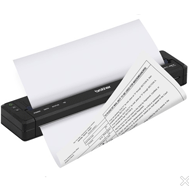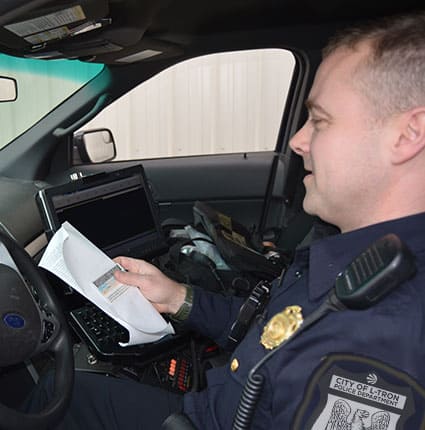Police officers are expert at telling stories and solving the world’s problems. At least at roll call with a cup of coffee, or at a bar over a beer.
But get a cop to feed one of those fresh thermal paper rolls into a patrol car’s mobile printer? It’s akin to changing the toilet paper roll at home. Even then, there’s that leading-edge question: Over or under?
No, thermal printer paper isn’t critical to every cop’s job, but even those who generate an in-car document can attest to when you’re out of thermal paper rolls it’s instantly the most inconvenient time, and it prompts the use of special words for the printer and the guy who had the car before you. Changing the thermal paper roll requires a distinct pause – a long, deep breath accepting the task at hand, and a sigh surrendering to bad luck. How does something so seemingly simple deflate the toughest cops?

The effort it takes to replace a roll of thermal paper is part of the secret to make documents magically appear without ink. Unless you replace the roll, the special coating on the paper won’t get burned by the hot print head to produce an image. But even when you replace the paper, some unanswered questions remain. And frustrations.
How do they get so many feet of paper on a roll? (Up to 230 feet!) It’s heavy enough to make a weapon out of. What’s the deal with the bright red plastic bag it’s in? Looks like a stick of dynamite. Was that wise? Who decided to tie off the bag with an impenetrable sticker? And once unwrapped, who at the paper company thought they needed to tape the leading edge with another indestructible sticker? Remember, cops solve world problems … in cop world, those two stickers … gone.
Time to replace the thermal paper roll. Time is of the essence. That poor motorist you pulled over is eagerly awaiting their ticket. (What? You’re only writing them one ticket?) First, you cram your body through the car door. It’s just not natural. The printer, whether crammed in the glove box or center console, is an inexplicable engineering feat. And who, exactly, thought it was a good idea to replace the passenger headrest with a printer? Why do the thermal paper rolls always need replacing when it’s raining?
No matter where the printer is, I always think of the Beatles song, “Twist and Shout.” In pain. If it’s in the center console, you force yourself through driver door – knees on the seat, duty belt pinned between steering wheel and seat. Vest and gravity pull at your already screaming back. If the printer is in the glove box, you go through the passenger door. Same with the head rest. No matter the location, replacing thermal paper rolls requires becoming a pretzel. Your partner’s suggestion you try yoga for your back doesn’t seem so ridiculous right now.
IMPORTANT: If you must replace a roll while in the middle of a traffic stop, have a second unit come by for officer safety. You’ll need backup to watch the occupant(s) of the vehicle you have pulled over. Read our Roadside Safety Blog series here.
If you can fit your sausage fingers into the innards of the thermal printer, you pull out the empty plastic (or cardboard) core. Save that for Tom on the night shift. They make great fetch-and-chew toys for his K-9 partner. If there’s a small length of paper left, tuck that in the passenger side visor. I discovered two (repurposed) uses for thermal paper. Falling somewhere between tinfoil and cheap paper towel, crumpled up, thermal paper is great for taking dead bugs off windshields, bumpers, and headlights. Since thermal paper isn’t absorbent, it’s also great for leaving notes on windshields in all sorts of weather, particularly if you use a Sharpie. I’ve also used it as an improvised envelope to collect trace evidence. And there was that time I ran out of gift wrap

As for the over-under question …
Open the printer BEFORE you run out of paper. You’ll see how the paper is fed. In my experience with several printers, the paper always fed from the underside of the roll. Since documents always came out print side up, that meant the coated print surface was the internal side. If you encounter an empty printer, open a new roll of paper and scratch each side of the paper with your finger. The side which produces a dark mark is the print side. There are plenty of manufacturer-specific (and printer-specific) YouTube videos which address feeding and adjusting alignment of thermal paper. One hint for feeding: crease the leading edge of the paper. Some printers will feed paper automatically, while others require you to press a feed button.
If you have a printer without a built-in paper cutter, you’ll need to develop the skill of tearing off the document from the machine – from the driver seat – without destroying the document. (Echoes of “Twist and Shout”)
The ultimate solution to reducing thermal paper printer frustration is like most things, prepare ahead of time. Keep a spare roll in the car or your duty bag and learn how your mobile printer works.
L-Tron offers PocketJet compatible continuous and perforated thermal media for your patrol car. Our durable paper is offered between $100 and $200 less than competitor offerings. For more on this thermal printer paper or to see if you qualify for a free roll, visit:
Additional Resources:
- A Thermal Media for Law Enforcement Overview.
- Thermal Printer Paper Products for Law Enforcement.
- Your Guide to ECitation from Start to Finish.
- In Car Printers for your Patrol Vehicle.
About the Author:

Hank Kula
Hank is a retired police sergeant with 26 years in law enforcement. A certified crime scene investigator and crash reconstructionist, Hank instructs police recruits in general topics. He also instructs veteran police officers in crime scene investigation and management, photography, and latent fingerprint processing. As a former road supervisor and manager of a forensics unit, he continues to instruct new sergeants in communications, writing, and report review. A former journalist, he has coordinated a biennial public information officer school for emergency responders. Click to read more blogs from Hank.